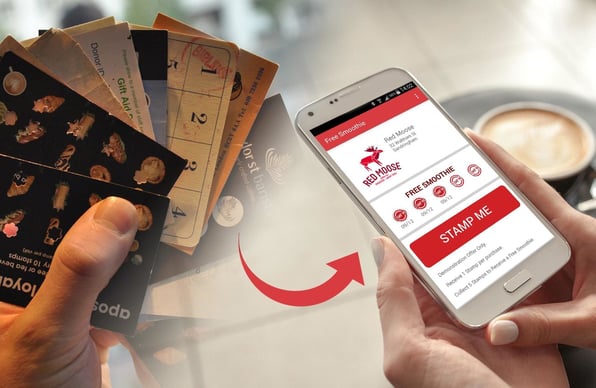Card-Based vs. Digital Loyalty Programs
This is a guest post from IT solutions firm TechnologyAdvice. You can find more tidbits of their recent research over on our loyalty stats and millennial loyalty stats collections.
According to recent research from Bridge. Over, 70% of Millennials believe their generation is less brand loyal than previous generations. Information firm Nielson meanwhile has found that up 78 percent of customers are not loyal to any particular brand. Given such findings, it’s more important than ever for companies to actively make an effort to court consumers and win repeat business. Loyalty marketing programs are one proven way to accomplish this. According to a recent customer loyalty survey we completed at TechnologyAdvice, people enrolled in customer loyalty programs are up to 82.4 percent more likely to shop at stores that offer similar programs. This strongly suggests that once customers are sold on the benefits of a loyalty system, they actively seek out opportunities to use it.
However, setting up a great loyalty program isn’t easy. With the rise in popularity of mobile devices, and recent trends in gamification, stores are now have to choose between implementing a traditional, card-based loyalty program (such a grocery store rewards card), or using a digital, smartphone-based system. We dove into the results of our research to help provide clarity for companies weighing their options.
Card-Based Rewards
Card-based systems are what started loyalty marketing. They can also be incredibly easy to implement. The simplest version of rewards cards are punch-cards, which are typically given out for free. Every time a customer buys a specific item (such as a coffee) a hole is punched in the card. After they collect a set number of these hole-punches, they receive a free item. This form of rewards program is most commonly used by small, often independent stores with limited resources.
A more sophisticated version of the same system is My Starbucks Rewards, which ties customer purchases into an online platform. This is typical of most modern card-based programs, which use a card as a convenient way to track customer buying habits and provide discounts or loyalty points. Grocery stores cards are another example, although they typically use an entirely discount-based system to attract customers.
According to our research, 36.8 percent of consumers prefer card-based loyalty programs over fully-digital systems. This is likely due to multiple factors, including the familiarity of such systems, and the convenience of having a physical card that can be carried in a wallet or attached to a key-ring.
There are downsides to such programs however. Unless a card-based system also offers a supplementary smartphone app, they are often unable to support targeted advertising, or offer location-specific discounts. This could be a weakness, depending on the retailer’s customer demographics. Still, card-based programs remain the loyalty system of choice for over a third of potential customers and merit a serious evaluation.
Digital Rewards
Borrowing heavily from the recent surge in gamification, digital rewards programs are the latest trend in customer loyalty. Companies such as Belly, LoyaltyMatch, and Splick-It all offer digital programs designed to provide more immediate benefit than traditional systems.
According to our findings, 33.3 percent of customers prefer digital-based programs, making them a close second to card-based programs. This suggests that while consumers want digital features, they may not yet be ready for fully digital systems. This could be due to the lack of available infrastructure right now (many store are not equipped to handle smartphone programs, so consumers may not see an immediate benefit), or because of the relatively recent creation of such systems. As consumers become more exposed to digital programs and become more comfortable with highly-targeted advertising, we expect that digital-based programs will become the prefered loyalty system for most customers.
Even if they aren’t yet ready for fully digital programs, consumers do favor digital elements. 59 percent of customers, for instance, said they would be more likely (or much more likely) to join a rewards program that offered a smartphone app. Another 56.6 percent of consumers said they would be more inclined to participate in a system that offered exclusivity-based rewards, like VIP status. While this is possible to achieving using a card-based system (you can use different tiers of cards), exclusivity-based rewards are much easier to manage with a digital program, where customers can track their progress towards higher levels and instantly unlock new rewards.
It’s also worth noting that 29.9 percent of customers reported being unsure of which type of program they prefer. These customers are likely willing to use either type of program, depending on the rewards and features offered. In order to win over such consumers, brands will need to convincingly demonstrate the benefits of their rewards program, whether it’s card or digital-based.
Which Program Is Right for Your Company?
Analyzing the results of our study, it appears card-based systems that offer supplementary smartphone apps are the safest choice of loyalty program for companies looking to implement their own system. Of course, there are business-specific variables to take into account. If your customer base is primarily made up of younger, digitally-savvy people, an app-based rewards program may be more successful. If your customer base is wider, or skews older, a more traditional card-based system will likely see higher adoption. By taking into consider the above findings, surveying your own customer base, and partnering with a reliable customer loyalty vendor, you can begin to realize the massive potential of a successful rewards program.
Author Bio:
Cameron Graham is the Editorial Coordinator at TechnologyAdvice. He oversees market research for gamification, business intelligence, and other emerging technologies.
Topics: Rewards Programs, Customer Engagement, Discount Programs, Card-Linked Offers, Access Development, customer loyalty, guest posts
Written by: Brandon Carter







.jpeg)






Share your Comment.